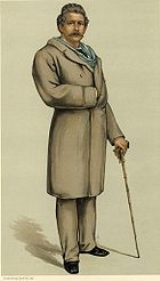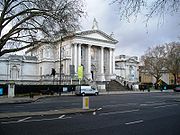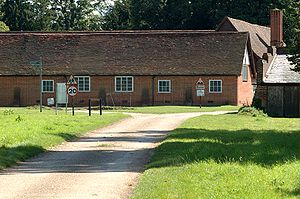
Charles Bennett Lawes
Encyclopedia
Sir Charles Bennett Lawes-Wittewronge, 2nd Baronet (3 October 1843 – 6 October 1911) was an English rower
, athlete and sculptor. He exhibited twelve works at the Royal Academy
.
 Lawes was born at Teignmouth
Lawes was born at Teignmouth
, the only son of Sir John Lawes
of Rothamsted. He was educated at Eton
and Trinity College, Cambridge
. At Cambridge he won the Colquhoun Sculls in 1862 and won the Diamond Challenge Sculls
at Henley Royal Regatta
in 1863. He excelled in the university distance running events and received an athletics Blue in 1864 for the mile at the Inter University sports, which he won again in 1865. He was a rowing Blue in 1865 when he stroked the losing Cambridge crew in the Boat Race but was in the winning crew of the Ladies' Challenge Plate
at Henley. He was beaten by Edward Michell
in the Diamond Challenge Sculls in 1865, but won the Wingfield Sculls beating Walter Bradford Woodgate
. In 1865 he was the Amateur Athletics Club champion for the mile.
Lawes decided to become a sculptor, and began his training in London under John Henry Foley
RA. In 1869 he studied under Hugo Hagen in Berlin. He rented a studio in Chelsea, and in 1872 he exhibited his first work at the Royal Academy "Girl at the Stream". In 1878 he won an honourable mention at the Paris Universal Exhibition. Further exhibits at the Royal Academy were "Daphne" in 1880 and "The Panther" in 1881. Lawes also carried out work for the scientific side of the Lawes Agricultural Trust, founded by his father, and became its chairman.
In 1882 Lawes was involved in a libel case after he had imputed in the magazine Vanity Fair
and elsewhere that another sculptor, Richard Claude Belt, was dishonest for taking credit for work done by someone else. The long trial—the last one to be heard by the High Court of Justice
in Westminster Hall—occupied the court for 43 sittings and excited much public interest at the time. The question at issue was how much a sculptor may be aided by others in work to which he attaches his name. Eventually the case was decided against Lawes, and Belt was awarded £5,000 damages.
In 1898, at age fifty-five, Lawes took up cycle racing and held the National Cycling Union amateur record for twenty-five miles, covering it in 51 minutes 15.8 seconds.

 Lawes succeeded his father as Baronet
Lawes succeeded his father as Baronet
on 31 August 1900, and in 1902 he assumed for himself and his heirs by Royal Licence the additional surname (and arms) of Wittewronge. He was one of the founders of the Royal Society of British Sculptors in 1902 and became its second president. Lawes-Wittewronge created a colossal marble group, "The Death of Dirce". (Dirce
: a woman in Greek mythology.) Bronze versions of this were exhibited in 1906 at the Royal Academy and in 1908 at the Franco-British Exhibition. In 1911, the marble group was exhibited at the International Fine Arts Exhibition in Rome, where Lawes helped to arrange the British sculpture. This was later erected at the family estate at Rothamsted and a smaller bronze replica became part of the collections of the Tate Gallery
and stands outside the entrance of Tate Britain
.
In 1902, Lawes helped judge the world's first major bodybuilding competition. Organized by famed strongman Eugen Sandow
, the event was held in London's Royal Albert Hall
, and was judged by Lawes, Sir Arthur Conan Doyle, author of Sherlock Holmes
, as well as Sandow himself.
Lawes married Marie Amelie Rose on 8 April 1869. Their only child, John, succeeded to the baronetcy on his father's death at Rothamsted at the age of 68, after an operation for appendicitis.
Rowing (sport)
Rowing is a sport in which athletes race against each other on rivers, on lakes or on the ocean, depending upon the type of race and the discipline. The boats are propelled by the reaction forces on the oar blades as they are pushed against the water...
, athlete and sculptor. He exhibited twelve works at the Royal Academy
Royal Academy
The Royal Academy of Arts is an art institution based in Burlington House on Piccadilly, London. The Royal Academy of Arts has a unique position in being an independent, privately funded institution led by eminent artists and architects whose purpose is to promote the creation, enjoyment and...
.

Teignmouth
Teignmouth is a town and civil parish in Teignbridge in the English county of Devon, situated on the north bank of the estuary mouth of the River Teign about 14 miles south of Exeter. It has a population of 14,413. In 1690, it was the last place in England to be invaded by a foreign power...
, the only son of Sir John Lawes
John Bennet Lawes
Sir John Bennet Lawes, 1st Baronet FRS was an English entrepreneur and agricultural scientist. He founded an experimental farm at Rothamsted, where he developed a superphosphate that would mark the beginnings of the chemical fertilizer industry.John Bennet Lawes was born at Rothamsted in...
of Rothamsted. He was educated at Eton
Eton College
Eton College, often referred to simply as Eton, is a British independent school for boys aged 13 to 18. It was founded in 1440 by King Henry VI as "The King's College of Our Lady of Eton besides Wyndsor"....
and Trinity College, Cambridge
Trinity College, Cambridge
Trinity College is a constituent college of the University of Cambridge. Trinity has more members than any other college in Cambridge or Oxford, with around 700 undergraduates, 430 graduates, and over 170 Fellows...
. At Cambridge he won the Colquhoun Sculls in 1862 and won the Diamond Challenge Sculls
Diamond Challenge Sculls
The Diamond Challenge Sculls is a rowing event for men's single sculls at the annual Henley Royal Regatta on the River Thames at Henley-on-Thames in England...
at Henley Royal Regatta
Henley Royal Regatta
Henley Royal Regatta is a rowing event held every year on the River Thames by the town of Henley-on-Thames, England. The Royal Regatta is sometimes referred to as Henley Regatta, its original name pre-dating Royal patronage...
in 1863. He excelled in the university distance running events and received an athletics Blue in 1864 for the mile at the Inter University sports, which he won again in 1865. He was a rowing Blue in 1865 when he stroked the losing Cambridge crew in the Boat Race but was in the winning crew of the Ladies' Challenge Plate
Ladies' Challenge Plate
The Ladies' Challenge Plate is one of the events at Henley Royal Regatta on the River Thames at Henley-on-Thames in England. Crews of men's eight-oared boats below the standard of the Grand Challenge Cup can enter, although international standard heavyweight crews are not permitted to row in the...
at Henley. He was beaten by Edward Michell
Edward Michell
Edward Blair Michell was an English barrister and rower who won the Wingfield Sculls in 1866 and the Diamond Challenge Sculls at Henley Royal Regatta in 1866 and 1867...
in the Diamond Challenge Sculls in 1865, but won the Wingfield Sculls beating Walter Bradford Woodgate
Walter Bradford Woodgate
Walter Bradford Woodgate was a British barrister and oarsman who won the Wingfield Sculls three times, and various events at Henley Royal Regatta including the Silver Goblets five times and the Diamond Challenge Sculls once...
. In 1865 he was the Amateur Athletics Club champion for the mile.
Lawes decided to become a sculptor, and began his training in London under John Henry Foley
John Henry Foley
John Henry Foley , often referred to as JH Foley, was an Irish sculptor, best known for his statues of Daniel O'Connell in Dublin, and of Prince Albert in London. Both are still considered iconic in each city.-Life:...
RA. In 1869 he studied under Hugo Hagen in Berlin. He rented a studio in Chelsea, and in 1872 he exhibited his first work at the Royal Academy "Girl at the Stream". In 1878 he won an honourable mention at the Paris Universal Exhibition. Further exhibits at the Royal Academy were "Daphne" in 1880 and "The Panther" in 1881. Lawes also carried out work for the scientific side of the Lawes Agricultural Trust, founded by his father, and became its chairman.
In 1882 Lawes was involved in a libel case after he had imputed in the magazine Vanity Fair
Vanity Fair (British magazine)
The second Vanity Fair was a British weekly magazine published from 1868 to 1914.-History:Subtitled "A Weekly Show of Political, Social and Literary Wares", it was founded by Thomas Gibson Bowles, who aimed to expose the contemporary vanities of Victorian society. The first issue appeared in London...
and elsewhere that another sculptor, Richard Claude Belt, was dishonest for taking credit for work done by someone else. The long trial—the last one to be heard by the High Court of Justice
High Court of Justice
The High Court of Justice is, together with the Court of Appeal and the Crown Court, one of the Senior Courts of England and Wales...
in Westminster Hall—occupied the court for 43 sittings and excited much public interest at the time. The question at issue was how much a sculptor may be aided by others in work to which he attaches his name. Eventually the case was decided against Lawes, and Belt was awarded £5,000 damages.
In 1898, at age fifty-five, Lawes took up cycle racing and held the National Cycling Union amateur record for twenty-five miles, covering it in 51 minutes 15.8 seconds.


Lawes Baronets
The Lawes Baronetcy, of Rothamsted in the County of Hertford, is a title in the Baronetage of the United Kingdom. It was created on 19 May 1882 for the entrepreneur and agricultural scientist John Bennet Lawes.-Lawes Baronets, of Rothamsted :...
on 31 August 1900, and in 1902 he assumed for himself and his heirs by Royal Licence the additional surname (and arms) of Wittewronge. He was one of the founders of the Royal Society of British Sculptors in 1902 and became its second president. Lawes-Wittewronge created a colossal marble group, "The Death of Dirce". (Dirce
Dirce
Dirce was the wife of Lycus in Greek mythology, and aunt to Antiope whom Zeus impregnated. Antiope fled in shame to King Epopeus of Sicyon, but was brought back by Lycus through force, giving birth to the twins Amphion and Zethus on the way...
: a woman in Greek mythology.) Bronze versions of this were exhibited in 1906 at the Royal Academy and in 1908 at the Franco-British Exhibition. In 1911, the marble group was exhibited at the International Fine Arts Exhibition in Rome, where Lawes helped to arrange the British sculpture. This was later erected at the family estate at Rothamsted and a smaller bronze replica became part of the collections of the Tate Gallery
Tate Gallery
The Tate is an institution that houses the United Kingdom's national collection of British Art, and International Modern and Contemporary Art...
and stands outside the entrance of Tate Britain
Tate Britain
Tate Britain is an art gallery situated on Millbank in London, and part of the Tate gallery network in Britain, with Tate Modern, Tate Liverpool and Tate St Ives. It is the oldest gallery in the network, opening in 1897. It houses a substantial collection of the works of J. M. W. Turner.-History:It...
.
In 1902, Lawes helped judge the world's first major bodybuilding competition. Organized by famed strongman Eugen Sandow
Eugen Sandow
Eugen Sandow , born Friedrich Wilhelm Müller, was a Prussian pioneering bodybuilder in the 19th century and is often referred to as the "Father of Modern Bodybuilding".-Early life:...
, the event was held in London's Royal Albert Hall
Royal Albert Hall
The Royal Albert Hall is a concert hall situated on the northern edge of the South Kensington area, in the City of Westminster, London, England, best known for holding the annual summer Proms concerts since 1941....
, and was judged by Lawes, Sir Arthur Conan Doyle, author of Sherlock Holmes
Sherlock Holmes
Sherlock Holmes is a fictional detective created by Scottish author and physician Sir Arthur Conan Doyle. The fantastic London-based "consulting detective", Holmes is famous for his astute logical reasoning, his ability to take almost any disguise, and his use of forensic science skills to solve...
, as well as Sandow himself.
Lawes married Marie Amelie Rose on 8 April 1869. Their only child, John, succeeded to the baronetcy on his father's death at Rothamsted at the age of 68, after an operation for appendicitis.

